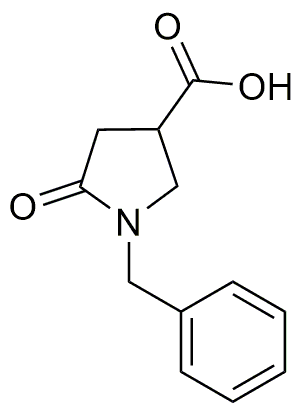1-Benzyl-5-oxopyrrolidine-3-carboxylic acid is widely utilized in research focused on:
- Pharmaceutical Development: This compound serves as a key intermediate in the synthesis of various pharmaceuticals, particularly in the development of analgesics and anti-inflammatory drugs.
- Biochemical Research: It is used in studies investigating enzyme inhibition and receptor binding, helping researchers understand drug interactions and biological pathways.
- Organic Synthesis: The compound acts as a versatile building block in organic chemistry, facilitating the creation of complex molecules for various applications.
- Material Science: It finds applications in the development of polymers and materials, enhancing properties such as strength and durability in industrial products.
- Cosmetic Formulations: This chemical is incorporated into cosmetic products for its potential skin benefits, contributing to formulations aimed at improving skin texture and appearance.
General Information
Properties
Safety and Regulations
Applications
1-Benzyl-5-oxopyrrolidine-3-carboxylic acid is widely utilized in research focused on:
- Pharmaceutical Development: This compound serves as a key intermediate in the synthesis of various pharmaceuticals, particularly in the development of analgesics and anti-inflammatory drugs.
- Biochemical Research: It is used in studies investigating enzyme inhibition and receptor binding, helping researchers understand drug interactions and biological pathways.
- Organic Synthesis: The compound acts as a versatile building block in organic chemistry, facilitating the creation of complex molecules for various applications.
- Material Science: It finds applications in the development of polymers and materials, enhancing properties such as strength and durability in industrial products.
- Cosmetic Formulations: This chemical is incorporated into cosmetic products for its potential skin benefits, contributing to formulations aimed at improving skin texture and appearance.
Documents
Safety Data Sheets (SDS)
The SDS provides comprehensive safety information on handling, storage, and disposal of the product.
Product Specification (PS)
The PS provides a comprehensive breakdown of the product’s properties, including chemical composition, physical state, purity, and storage requirements. It also details acceptable quality ranges and the product's intended applications.
Certificates of Analysis (COA)
Search for Certificates of Analysis (COA) by entering the products Lot Number. Lot and Batch Numbers can be found on a product’s label following the words ‘Lot’ or ‘Batch’.
Numéro de catalogue
Numéro de lot/série
Certificates Of Origin (COO)
This COO confirms the country where the product was manufactured, and also details the materials and components used in it and whether it is derived from natural, synthetic, or other specific sources. This certificate may be required for customs, trade, and regulatory compliance.
Numéro de catalogue
Numéro de lot/série
Safety Data Sheets (SDS)
The SDS provides comprehensive safety information on handling, storage, and disposal of the product.
DownloadProduct Specification (PS)
The PS provides a comprehensive breakdown of the product’s properties, including chemical composition, physical state, purity, and storage requirements. It also details acceptable quality ranges and the product's intended applications.
DownloadCertificates of Analysis (COA)
Search for Certificates of Analysis (COA) by entering the products Lot Number. Lot and Batch Numbers can be found on a product’s label following the words ‘Lot’ or ‘Batch’.
Numéro de catalogue
Numéro de lot/série
Certificates Of Origin (COO)
This COO confirms the country where the product was manufactured, and also details the materials and components used in it and whether it is derived from natural, synthetic, or other specific sources. This certificate may be required for customs, trade, and regulatory compliance.


